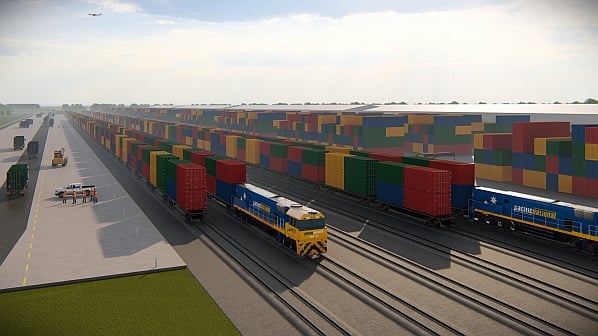AI Is More Than ChatGPT: The Supply Chain Opportunity Lies in Cognitive Decision-Making
There’s no escaping it — AI is everywhere. It’s the hot topic in boardrooms, conferences, and every discussion with business leaders. Everyone’s talking about how artificial intelligence will reshape industries, transform jobs, and unlock new efficiencies. But while the spotlight shines brightly on tools like ChatGPT, there’s a much more powerful AI story unfolding — one that’s quietly revolutionising how supply chains analyse, decide, and operate.

Beyond the Hype
AI hype is at an all-time high. Every day brings a new headline, a new app, or a new “game-changing” announcement. And in most conversations, when people say AI, what they really mean is generative AI — tools built on large language models (LLMs) that can write, summarise, design, and converse like humans.
It’s understandable why generative AI gets so much attention. The technology feels tangible — you type, it responds. It’s visible, easy to experiment with, and immediately valuable. Tools like ChatGPT, Claude, Gemini, and Copilot have revolutionised how we draft reports, analyse data, and search the web. For many professionals, generative AI has become a digital co-pilot — making work faster, smoother, and at times, even more creative.
But when it comes to real-world benefits, AI is much bigger than a conversation.
AI Has Many Branches
Artificial intelligence isn’t a single technology; it’s a vast ecosystem of disciplines that mimic different aspects of human capability. In his foundational book The Rise of AI, Matt Michalewicz identifies four branches corresponding to the major functions of the body:
- Robotics – replicating movement and enabling automation such as picking and packing on a production line
- Computer Vision – allowing machines to “see” and interpret images, from quality control cameras to drones
- Natural Language Processing – helping systems understand and respond to human speech and text, such as a customer chatbot
- Cognitive Computing – focused on replicating the function of thinking; enabling systems to reason, learn from context, and make decisions
It’s this last one, cognitive computing, that is the most exciting frontier for supply chain and operations. It holds immense potential for industries built on complexity, variability, and speed.
Why Supply Chain Is Ripe for AI-Driven Transformation
Few business functions generate as much data, or face as much volatility, as supply chain. Every day, millions of data points flow through ERP networks — sales orders, forecasts, production output, material requests, transport movements — all impacting, or impacted by, supplier performance, quality issues, breakdowns, lead times, weather patterns, traffic congestion, and consumer trends.
Historically, making sense of this data has been a human endeavour. Analysts pore over spreadsheets, planners debate scenarios, and managers make decisions based on experience and intuition. These decisions can be smart, even inspired, but they’re limited by human bandwidth.
A planner might be able to interpret hundreds of data points; an algorithm can process billions.
And that’s the opportunity.
The next wave of AI in supply chains isn’t about replacing people — it’s about augmenting human decision-making with machine intelligence that can analyse, predict, and act in real time.
From Data Interpretation to Decision Intelligence
For decades, supply chains have been built around interpreting data. Systems collect and visualise information, dashboards present insights, and people decide what to do next.
Now, we’re moving beyond that paradigm. AI enables supply chains not just to interpret data but to learn from it, anticipate outcomes, and make optimised decisions — autonomously or in collaboration with humans.
Imagine this:
- AI monitors every SKU across a multi-country network, predicting where demand will surge and automatically adjusting inventory allocation.
- It analyses real-time transport data and reroutes shipments before disruptions occur.
- It identifies production bottlenecks before they escalate, optimising scheduling and labour deployment dynamically.
- It evaluates thousands of “what-if” scenarios in minutes, helping leaders select the best course of action with confidence.
This is cognitive decision-making in action — the fusion of data, analytics, and machine learning to drive real-time decisions that shape the physical world.
Three Core Advantages of Cognitive AI in Supply Chain
1. Interpreting Massive Volumes of Data
The modern supply chain operates in an ocean of information — demand signals, weather forecasts, commodity prices, social sentiment, IoT sensor data. Humans simply can’t interpret it all.
AI thrives here. Machine learning models detect patterns invisible to humans, uncovering subtle correlations — like how regional social media trends might influence short-term demand spikes or how port congestion in the Netherlands affects shipping lead-times to Australia.
The result: richer insight, faster.
2. Making Better Predictions
Traditional forecasting relies heavily on historical data and assumes tomorrow will look a lot like yesterday. But the world no longer behaves predictably.
AI-based predictive models continuously learn from new data — adjusting forecasts as reality shifts. They can integrate external data like macroeconomic indicators or weather events to sharpen accuracy.
The payoff is tangible: reduced stockouts, leaner inventory, and better service levels. In fast-moving categories, that could mean an extra day’s shelf life, fewer markdowns, and millions saved in working capital.
3. Operating at Unprecedented Speed and Scale
In supply chain management, timing is everything. A delayed decision can cascade into lost sales, idle assets, or missed opportunities.
AI systems don’t wait for weekly reports or monthly reviews. They can process live data streams and act instantly — recommending a supplier switch, a stock level adjustment, or a transport re-route before humans even know there’s a problem.
This shift from reactive to proactive decision-making is where AI delivers its greatest value. It enables supply chains to operate in real time — adapting dynamically to whatever the market, customers, or environment throws at them.
Humans + Machines = The Future of Decision-Making
One of the biggest fears about AI is that it’s here to replace people. In reality, its greatest strength lies in working with people.
Machines are exceptional at pattern recognition, computation, and consistency. Humans excel at empathy, ethics, and contextual understanding. Combine the two, and you get a system that’s faster, smarter, and more resilient than either alone.
In practice, this means supply chain professionals shifting from “data crunching” to decision orchestration. AI generates insights and recommendations; humans validate them, set strategic boundaries, and make final calls where nuance matters.
As AI takes over routine analytical work, planners can focus on higher-value activities — innovation, supplier collaboration, sustainability initiatives, and risk management.
This is not a loss of control; it’s a gain in capability.
Real-World Impact: From Theory to Transformation
Many leading organisations are already experimenting — and succeeding — with cognitive AI.
- Retailers are using AI to optimise store replenishment in real time, cutting waste and improving on-shelf availability.
- Manufacturers are deploying machine-learning models to predict equipment failure before it happens, reducing downtime and maintenance costs.
- Logistics providers are using dynamic routing algorithms to slash delivery times and fuel consumption.
- Food producers are analysing temperature, humidity, and transit data to maximise product freshness and shelf life.
These are not isolated experiments; they’re proof that AI’s impact is moving from digital dashboards into the physical supply chain — decisions that move trucks, fill shelves, and balance networks.
The Road Ahead: Building Intelligent, Adaptive Networks
The future supply chain will not just be digital; it will be intelligent and self-optimising.
Cognitive systems will continuously learn from every transaction, every shipment, and every deviation. They’ll simulate scenarios before they happen, balancing trade-offs between cost, service, and sustainability in real time.
But technology alone won’t deliver the transformation. Success will depend on:
- Data quality and integration — clean, connected data across the entire value chain
- Change leadership — building trust in AI-driven decisions, supporting team upskilling, and developing an adaptable team culture
- Strategic vision — aligning AI initiatives with real business outcomes
- Strong governance — ensuring transparency to build trust and maintain accountability
The companies that master this balance will be the ones that thrive in an uncertain world.
AI Amplifies Strong Supply Chain Foundations — It Doesn’t Replace Them
AI is far more likely to take a supply chain from a 94% to a 98% service level than from a 50% to an 80% forecast accuracy — because the former assumes the fundamentals are already strong.
When the underlying processes, data integrity, and system foundations are sound, AI can deliver marginal yet powerful gains by identifying micro-patterns, leading indicators, and latent correlations that humans can’t see. These small increments compound into significant performance improvements — shaving days off lead times or reducing safety stock without compromising service.
But when the base data or process design is flawed — poor master data, inaccurate BOMs, inconsistent supplier performance, or weak planning discipline — even the most sophisticated AI models will struggle.
The same logic applies to forecasting: AI can refine an already well-calibrated forecast, but it cannot compensate for missing structural inputs. The key is sequencing — get the foundations right first (data, processes, and governance), then apply AI in targeted, high-value areas.
For example, using AI to overlay external leading indicators (like commodity price changes or shipping congestion) can dynamically adjust supplier lead-time variability — resulting in more precise safety stock calculations and fewer stockouts.
AI amplifies excellence — but it can’t manufacture it from instability.
AI’s True Potential
Despite the potential, many organisations struggle to move from pilots to enterprise-scale adoption. Common hurdles include siloed data, unclear ownership, and fear of algorithmic opacity. Successful adoption requires strong data governance, executive sponsorship, and trust in AI-assisted decision-making — not blind automation.
Between now and 2030, the organisations that thrive will be those that combine human insight with machine intelligence. AI won’t just optimise supply chains — it will redefine them.
The question isn’t if your supply chain will think for itself — it’s when, and whether you’ll be ready to trust it.
When we think about AI, it’s easy to picture a chatbot writing emails or summarising reports. That’s powerful — but it’s only scratching the surface.
The real magic happens when AI stops talking about the world and starts acting in it — when it transforms how decisions are made, how goods flow, and how people work.
AI is not just about conversation. It’s about cognition.
And for supply chains — the complex, beating heart of global business — that’s where the real opportunity begins.



.webp)
































